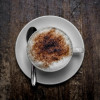The French Teaching Kitchen
Interview with
Jane - If conjugating verbs isn't your idea of an interesting way to learn a language, the latest research at Newcastle University could be just the thing for you. Language experts and computer scientists have developed an innovative kitchen that gives lessons in cooking and French at the same time. It tracks your actions with motion sensor technology and it speaks to you as you prepare your dish. Professor Paul Seedhouse is involved in the linguistic side of the project.
Paul - This research has been based on previous research done by my colleague Patrick Olivier in Computing Science in Newcastle. He developed a digital kitchen for people with dementia. So for example, if they left the oven on for too long, it would tell them to turn it off and when I saw that, I thought that the technology could be adapted for use with language learning and teaching.
Paul - When you enter the kitchen, it looks pretty much like an ordinary  kitchen. Some of the differences you'll notice if you look at the kitchen equipment, the handles are larger than normal and that's because they have sensors embedded. And this technology you may be familiar with already, it's similar to Nintendo Wii technology, so there are sensors and they detect movement in all directions. The kitchen will then speak to you in French.
kitchen. Some of the differences you'll notice if you look at the kitchen equipment, the handles are larger than normal and that's because they have sensors embedded. And this technology you may be familiar with already, it's similar to Nintendo Wii technology, so there are sensors and they detect movement in all directions. The kitchen will then speak to you in French.
---
Paul - When you're actually doing the cooking, you have a number of alternatives open to you. You can request a repetition or you can ask for a translation or you can pause a program, you can go backwards and forwards. But a really important point about this learning environment is that we put people in pairs. Typically, one person is better at French, one person is better at cooking, and that means that they transfer the skills and they help each other to learn.
---
Paul - The recipe we've got is called a pear clafoutis and it tells you first of all to peel the pears. So first of all, it tells you to take four pairs and the system then detects that you've taken the package of pears and you've moved it onto the work surface. It then tells you to take the peeler and so, the sensor in the peeler will then detect that you've taken it over. It's being moved and then the system will then detect whether you've made the correct peeling motion with your peeler on the pears. When you've done that, it'll tell you to cut the pears into four so then it will look and see, have you taken the knife, has the knife moved over to the surface, and then have you made the correct chopping motion with the knife. If you don't make a chopping motion with the knife - let's say you move it from side to side, it won't detect that as correct and so, the system will loop back and give you the instructions again.
---
Jane - Dan Jackson and Jurgen Wagner are involved in the technical aspects of the project. They explained more about the small sensing devices that are embedded in the kitchen utensils
Dan - Fundamentally, we're interested in understanding how the objects are used and how they're being manipulated. We've developed this hardware that actually detects the motion, uses something called an accelerometer which is a device that measures the acceleration.
 Jurgen - The accelerometer inside tracks the smallest movements you do with your hands, the smallest movement you do with the utensils. These are called motion primitives and this information is sent over to a computer which acts as a base station and this base station translates these simple activities, these motion primitives into something more meaningful. Whether it was it a chopping activity, a stirring activity, or whatever activity we can measure.
Jurgen - The accelerometer inside tracks the smallest movements you do with your hands, the smallest movement you do with the utensils. These are called motion primitives and this information is sent over to a computer which acts as a base station and this base station translates these simple activities, these motion primitives into something more meaningful. Whether it was it a chopping activity, a stirring activity, or whatever activity we can measure.
Dan - So for instance, if you pick up a utensil, the device will wake up from a sleep state and it will start broadcasting its motion to the computer. And then on the computer, we can analyse that information and work out what that object is being used for. Chopping with a knife would give us a different signal to someone scraping or slicing with the same knife.
---
Jane - As well as making learning fun, Paul Seedhouse says the kitchen builds on the proven technique of task based language learning. There are now further plans to take the concept out to wider a audience.
Paul - Well, from the point of view of language learning and teaching, it's unique because it's taking the ideas, the excellent ideas of task based learning and teaching out of the classroom and if you like, into the kitchen. You're combining it with a real world task. It's also unique and that you're learning two skills at the same time: in other words, French and cooking skills. So we already have the full scale digital kitchen in Newcastle University but we have now developed a series of portable kitchens which we take out on road shows. It's basically a tablet PC, 6 implements and a pair of speakers, so it's very portable. We're going to be placing portable kitchens in four different countries in Europe and trying them out there.
Jane - The research is supported by the digital economy program run by the Engineering and Physical Sciences Research Council. In the future, this way of learning could be used to teach people any number of skills ranging from nursing to driving. This new type of kitchen could be available for schools, universities, and even the domestic market by the end of 2012.










Comments
Add a comment